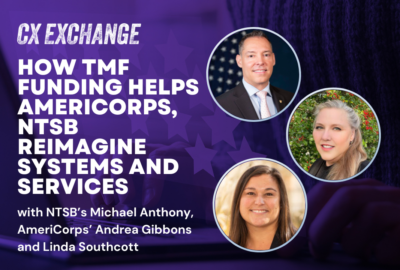NTSB’s reels of microfiche are its perfect AI use case
Michael Anthony, the chief information officer of the NTSB, said AI would improve access to information and make decision making better.
The National Transportation Safety Board is peeling back the artificial intelligence onion and starting with the easy outer layers.
That means the agency is seeing how it could apply AI tools to pull out historical information the agency captured on microfiche over the last several decades.
“We redact personally identifiable information (PII) for all information nowadays, but our historical information that was captured via microfiche that we’re in the process of digitizing has never been redacted, so it’s a perfect use case to apply AI to really reduce the manual burden of that,” said Michael Anthony, the chief information officer of the National Safety Transportation Board, on Ask the CIO. “There’s also some other use cases that we’re exploring that really allows us to search and analyze our own data — our own accident data, for instance, safety recommendations — to really streamline the process for identifying similarities between different recommendations. With attrition and retirements, you really do lose the institutional knowledge and AI can really help us regain that, or for new staff members who don’t have historical knowledge, it can really be a game changer, perhaps with respect to analyzing information and helping us make more informed decisions.”

The microfiche example is a good one, not just for NTSB, but for many agencies that need to redact data that would normally take a lot of time and resources. Through AI, the time can be reduced from days or hours to minutes.
Anthony said being able to strip out the PII and make the data more usable to the staff becomes more important because NTSB’s investigations never really close.
“We’re in the process of digitizing our own information, our historical legacy information, and along with that, there’s new requirements such as the Evidence Act, that all this information needs to be meta tagged for more useful use later on. We’re just beginning that journey and we’re doing our market research. But it’s certainly a use case that is perfect for artificial intelligence,” he said. “A lot of our aircraft that are currently flying are 10, 20, 30, maybe even 40 years old and some of those accident investigations from 40 years ago might not be in a digital format today so we’re not sure if there are some unknown unknowns. So we absolutely believe this capability can not only help our internal investigators, but also the external public who want information from maybe a historical accident that isn’t currently available to them today.”
Potentially by applying AI tools, all of that information may be easier to search in a more intuitive way, he added.
While NTSB still is in the early stages of market research, Anthony said he expects the agency will need some contractor help to digitize the information, so an acquisition is forthcoming.
One area where the NTSB already is spending money is customer experience. The agency received a $16.2 million investment or loan from the Technology Modernization Fund board in July 2023 to help accelerate improvements to its transportation accident investigations for public safety.
The TMF Board said the agency has received $2.9 million so far with the goals of:
- Centralizing accident data to improve search capabilities.
- Reimagining the process for report publishing and document management.
- Sharing near real-time datasets, including investigation progress.
- Creating customer notifications.
Anthony said if a citizen or research goes to NTSB’s website today, there are multiple ways to search for information and most people will be lucky if they can find what they want.
But with the TMF money, he said the board will make searching for information more streamlined, more simple and intuitive and easily accessible.
“Today, when we share information with other federal agencies, it’s typically on a batch process that we do once a month. We really should be using modern secure application programming interfaces (APIs) so that the other agency can pull the information whenever they want it or at least near real time,” Anthony said. “None of these things are rocket science. They’re all doable with proven technology so what the TMF is allowing us to really do is bring them out things a lot quicker than what our normal appropriations would allow for. In September, it will be our first year so we have different milestones, or tollgates, that we’re tracking. One of those is to introduce an automated 6120 form, which is for the aviation for pilots, when they’re reporting an accident. It’s a pretty significant form, and it’ll be fully digitally enabled so a pilot can go in there, fill out information, they can actually save the information by being able to log back in with their user credentials and complete it.”
More than a fillable PDF
NTSB is implementing a content service platform, which is a secure repository for all of its investigation artifacts, which Anthony said will be something that they’re going to build upon over the next several years to have a robust, high quality database for all information.
NTSB created the current 6120 form about 30 years ago and it’s an 11 page PDF form with about 800 fields.
Anthony said when the agency releases the new form, it will be fully automated and fully integrated with their internal investigation system so data fields will automatically populate.
“When investigators are reviewing the form, we’ll be using some intelligence behind the scenes to highlight or flag things that maybe are inconsistent or that need to be reviewed further. So really, completely automating not only the entry of the information, but also how the investigator leverages that information. It really is much more than just a fillable PDF,” he said. “I would say this is a dramatic change, and the reason I say that is because we’re fully embracing the agile methodologies. To date, there’s only been pockets of that at NTSB and it’s been hit or miss. We’re going 100% all-in leveraging agile, and it’s been a change, even on day one, when we’re talking about the proposal, folks asked what were all the requirements? It was hard to explain to folks that we don’t have all the requirements upfront, and that’s not the agile methodology.”
Another key part of this modernization effort is the move to the cloud to do the DevSecOps development, which Anthony said will help future digitization projects.
A key change to implementing a DevSecOps or agile approach is explaining and showing the value of having one of the business partners and mission owners serve as a product owner.
Anothony said that person is helping to lead and guide the requirements, and ensure that there’s acceptance testing by the user community.
“Typically, technology is probably easy to do, but really getting the organization and the culture to really buy into a new way of doing business and embracing it is harder,” he said. “More often than not, there’s maybe only just a few individuals who are perhaps unwilling to adopt or try something new. I think that’s what leadership is all about, creating a safe space so that you can explore, you can perhaps fail, but fail fast.”
Copyright © 2024 Federal News Network. All rights reserved. This website is not intended for users located within the European Economic Area.
Jason Miller is executive editor of Federal News Network and directs news coverage on the people, policy and programs of the federal government.
Follow @jmillerWFED







